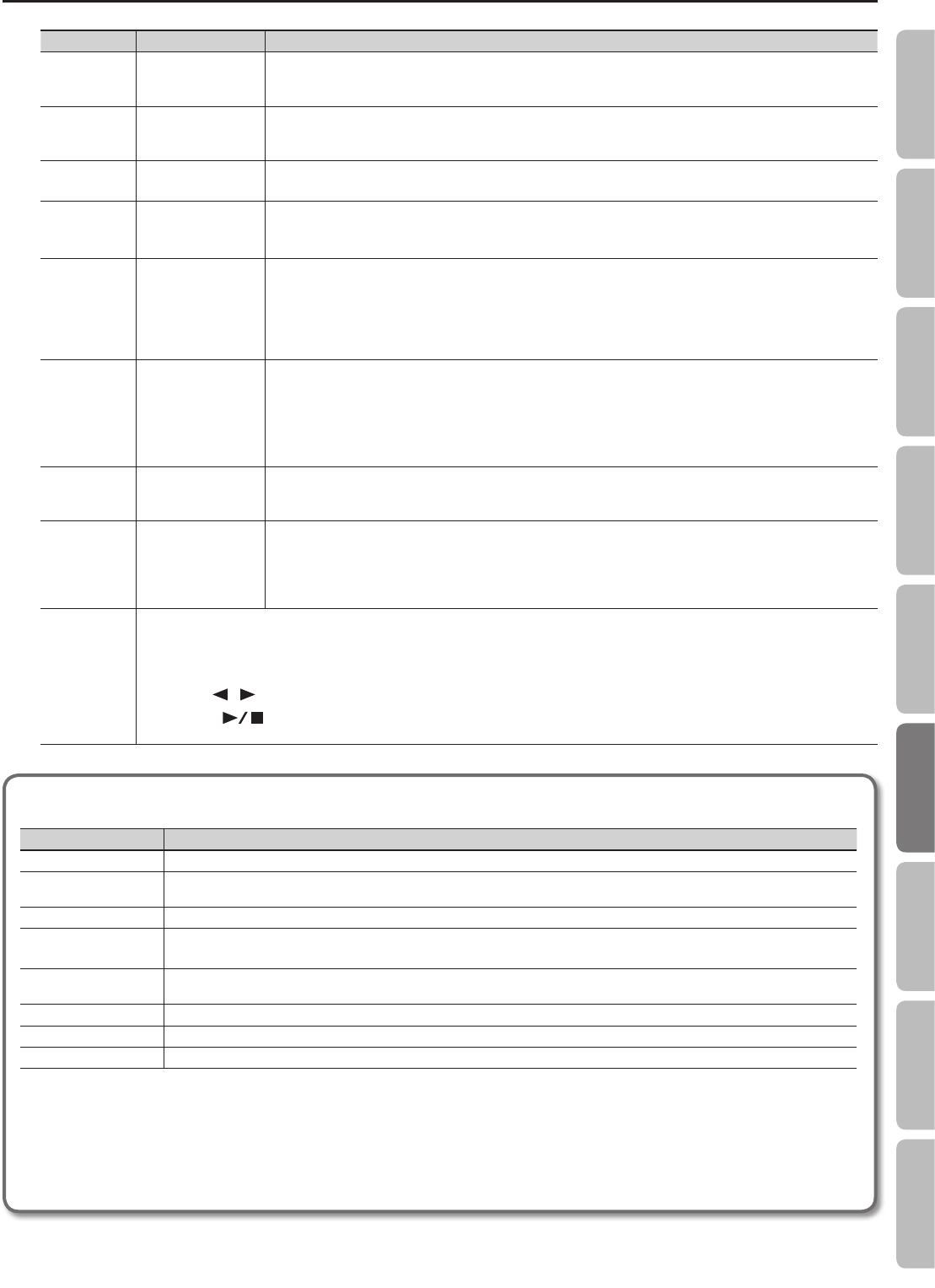
Personalizing Your Piano Sound (Piano Designer)
Parameter Value Description
String
Resonance
O, 1–10
(default: 5)
This adjusts the string resonance of the acoustic piano sound (the sympathetic vibrations of strings for previously played
notes that occur when you play another note).
Higher settings will make the sympathetic vibration louder.
Key O
Resonance
O, 1–10
(default: 5)
This adjusts sympathetic vibrations such as an acoustic piano’s key-o sound (the subtle sound that occurs when you
release a note).
Higher settings will make the sympathetic vibration louder.
Cabinet
Resonance
O, 1–10
(default: 4)
Adjusts the body resonance of the grand piano itself.
Higher values will produce a larger body resonance.
Damper Noise
O, 1–10
(default: 4)
This adjusts the damper noise of the acoustic piano sound (the sound of the damper releasing the strings when you press
the damper pedal).
* No damper noise will be heard if Damper Resonance is set to “O.”
Master Tuning
415.3–440.0–466.2 Hz
(default: 440.0 Hz)
This adjusts the LX-15’s standard pitch (the pitch of the middle A note).
When playing ensemble with other instruments and in other such instances, you can match the standard pitch to another
instrument.
The standard pitch generally refers to the pitch of the note that’s played when you nger the middle A key. For a cleaner
ensemble sound while performing with one or more other instruments, ensure that each instrument’s standard pitch is in
tune with that of the other instruments. This tuning of all the instruments to a standard pitch is called “master tuning.”
Temperament
Equal, Just Major, Just
Minor, Pythagorean,
Kirnberger, Meantone,
Werckmeister, Arabic
(default: Equal)
You can play classical styles such as Baroque using historic temperaments (tuning methods).
Most modern songs are composed for and played in equal temperament, the most common tuning in use today. But at one
time, there were a wide variety of other tuning systems in existence.
By playing in the temperament that was in use when a composition was created, you can experience the sonorities of
chords originally intended for that song.
For details, refer to “Temperaments”.
Temperament
Key
C–B
(default: C)
When playing with tuning other than equal temperament, you need to specify the temperament key for tuning the song to
be performed (that is, the note that corresponds to C for a major key or to A for a minor key).
If you choose an equal temperament, there’s no need to select a temperament key.
Stretch Tuning
O, Preset, User
(User: -50–0–+50)
(default: Preset)
This lets you specify the amount of “stretch tuning,” a tuning method specically for pianos, in which the high range is
tuned slightly sharper, and the low range is tuned slightly atter.
If you select “Preset,” a standard tuning curve created for the LX-15 will be used.
If you select “User,” you’ll be able to edit the stretched tuning yourself. Play the key whose pitch you want to adjust, then use
the [–] [+] buttons to adjust its pitch.
Piano Designer
Demo
For some parameters, you can listen to a demo song.
1. In step 2, choose “Piano Designer Demo.”
2. Press the [Song] button.
3. Use the [ ] [ ] (Slow/Fast) buttons to select the type of demo.
4. Press the [ ] (Play/Stop) button.
The demo will begin.
Temperaments
Temperament Qualities
Equal In this tuning, each octave is divided into twelve equal steps. Every interval produces about the same amount of slight dissonance.
Just Major
This tuning eliminates ambiguities in the fths and thirds. It is unsuited to playing melodies and cannot be transposed, but is capable of
beautiful sonorities.
Just Minor The Just tunings dier from major and minor keys. You can get the same eect with the minor scale as with the major scale.
Pythagorean
This tuning, devised by the philosopher Pythagoras, eliminates dissonance in fourths and fths.
Dissonance is produced by third-interval chords, but melodies are euphonious.
Kirnberger
This is an improvement of the Meantone and Just tunings that provides a high degree of freedom of modulation. Performances are possible
in all keys (III).
Meantone This scale makes some compromises in just intonation, enabling transposition to other keys.
Werckmeister This temperament combines the Meantone and Pythagorean tunings. Performances are possible in all keys (rst technique, III).
Arabic This tuning is suitable for the music of Arabia.
What is the duplex scale?
The Duplex Scale is a system of sympathetically vibrating strings sometimes included in grand pianos.
These sympathetically vibrating strings are not struck directly with hammers, but sound by vibrating in sympathy with the vibrations of other strings. By resonating with
the overtones, these strings add richness and brilliance to the sound. These sympathetic strings are added only to the high register above approximately C4. Since they do
not have a damper (a mechanism that stops them from sounding), they will continue sounding even after you play a note and then release it to stop the sound of the string
that was actually struck.
39
Operation Guide Panel Descriptions Before You Play Performing Practicing Piano Designer
Convenient Functions
Appendix
Function Mode


















